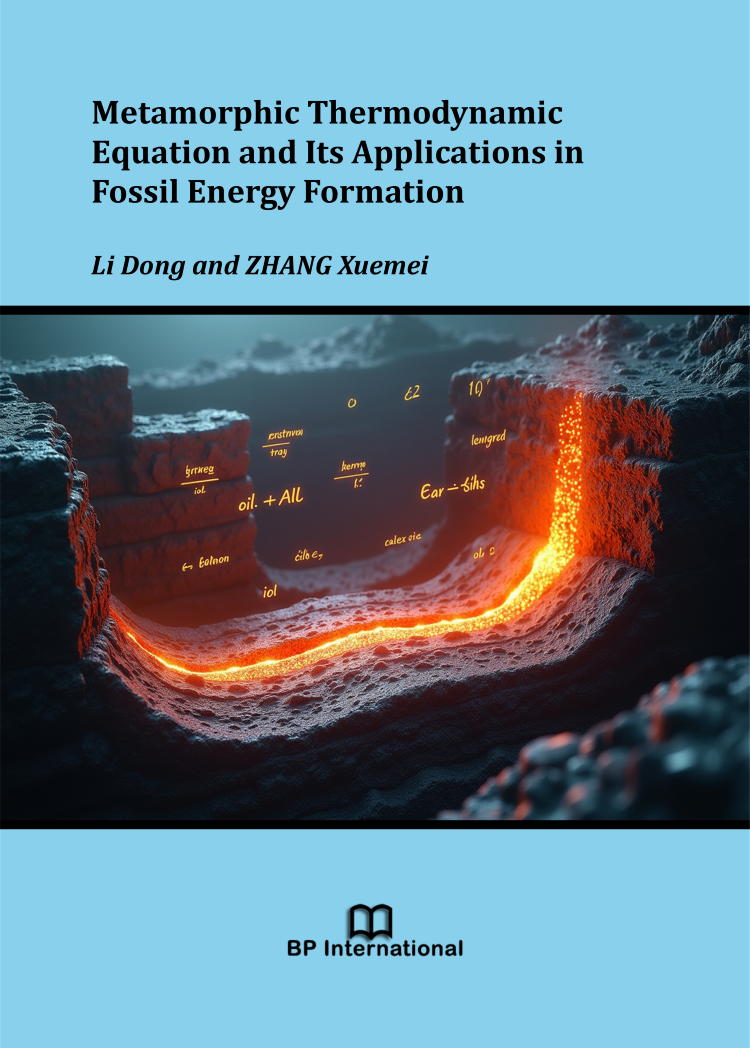Metamorphic Thermodynamic Equation and Its Applications in Fossil Energy Formation
Metamorphic Thermodynamic Equation and Its Applications in Fossil Energy Formation,
13 June 2025
,
Page 1-102
https://doi.org/10.9734/bpi/mono/978-93-49970-74-8
Abstract
The two important factors that affect the metamorphic processes of fossil energy (coal or petroleum) are temperature and time. Vitrinite reflectance is used to objectively reflect the maturation of sedimentary organic matter. There are three temperature measurement methods without using vitrinite reflectance and four temperature calculating methods using vitrinite reflectance only. The vitrinite reflectance gradient of coal is generally lower than 0.06%/100m in plutonic metamorphism. The vitrinite reflectance gradient of the regional magmatic thermal metamorphic coal is higher up to 0.27~0.57%/100m in Pingdingshan, China.
Wu established A metamorphic thermodynamic equation for coal (MTEC), which contains ternary functions (temperature, time and vitrinite reflectance), so the third quantity can be found on the premise that there are any two known quantities. The results of ternary equations can be expressed in tabular methods, graphing methods, and analytical methods. The MTEC is chosen as the comparison value, and the temperature obtained through other calculating methods as the basic value. The relative error, the average relative error, and the standard deviation are used to verify the applicability of MTEC. A time-to-temperature ratio t/T is designed to evaluate the relative contribution between the metamorphic temperature to the contribution of the extended time. There are three geological periods that can produce from low-rank coal (long-flame coal) to high-rank coal (anthracite) in China. In the three coal-forming periods, the time-to-temperature ratio was t/T>1 under all vitrinite reflectance examined, and the effect of increasing the temperature by 1°C was greater than that of extending the time by 1 million years, that is, the contribution of temperature was much greater than the contribution of extending time. During the same coal-forming period, with the increase of vitrinite reflectivity, the effect of temperature decreased significantly. At the same vitrinite reflectance, the significant effect of temperature decreases with the youth of coal-forming stage.
The MTEC is more convenient and accurate than diagrams and is more in line with the scientific principles of coal metamorphism. Because it is very difficult to directly solve the paleo geological time using MTEC, an iterative algorithm is used to solve this problem. Control the iteration process with the difference between the new and previous values so that the iteration process does not run endlessly. The golden ratio value of 0.618 is used to optimize the relationship between the value of the new iteration and the value of the previous iteration.
MTEC uses the calculated table to confirm that Xiao Xianming's simulation of vitrinite reflectance gradient and paleo geothermal temperature gradient shows that (1) vitrinite reflectance gradient is positively correlated with temperature gradient under fixed time and reflectance conditions. (2) In the case of fixed time and vitrinite reflectance gradient. The temperature gradient is negatively correlated with vitrinite reflectance. At the same time, it is also concluded that (3) in the case of fixed temperature gradient and vitrinite reflectance gradient. Vitrinite reflectance gradient is negatively correlated with time.
According to the measured static vitrinite reflectance and the corresponding burial depth of 26 coal samples in 4 groups of boreholes in the Huaibei coalfield, the temperature of 26 samples was calculated by MTEC at a time of 137 million years. Vitrinite reflectance gradient from measured vitrinite reflectance and burial depth. The results showed that Taoyuan and Xuton both have vitrinite reflectance of 0.057%/100m. They belong to plutonic metamorphism. But Qidong and Linhuan have a vitrinite reflectance of 0.105%/100m and 0.100%/100m, respectively. They belong to regional magmatic metamorphism. But plotting all 22 T/R0 ratios as vitrinite reflectance gradient vs temperature gradient can create a straight line with a slop of 56.3 °C/%, which means that the temperature-reflectance gradient ratio T/R0>50, and the metamorphism of Huaibei coalfield is the plutonic metamorphism.
The metamorphic thermodynamic equation for petroleum (MTEP) has the same functional form as the metamorphic thermodynamic equation for coal (MTEC) due to the similarity of both metamorphisms. Therefore, MTEP and MTEC have three variables, temperature, time and vitrinite reflectance, and have the exact same mathematic formation with different parameters. According to the dissimilarity of coal and petroleum, four parameters are determined to be completely different or partially different in the MTEP and MTEC two equations. The measurement data from an exploratory well in Indonesia provide sufficient data to validate the MTEP. Judging by the error of the measured reflectance of the stationary body, it is more reasonable to use the temperature judgment in this book. For the 15 measurement points of the Tertiary Period, the average relative error of temperature is <8.1% and the standard deviation of the relative error is <5.4%. For the 14 measurement points of the Mesozoic Era, the average relative error of temperature is <3.1% and the standard deviation of the relative error is <2.2%. This book translates a well-known hypothesis “either an increase in temperature of 10℃ or a doubling of the exposure time will double the rate of reaction” into a series of mathematical equations. And with the example of actual calculations, it is fully and beautifully demonstrated. For the 10-verification calculations of the Tertiary Period, the average relative error of temperature is <5.7% and the standard deviation of the relative error is <0.87%. For the 9-verification calculations of the Mesozoic Era, the average relative error of temperature is <8.3% and the standard deviation of the relative error is <0.13%. EXCEL and METLAB are used for simple calculations and drawing figures.
- Thermodynamic equation
- fossil
- energy formation
- vitrinite reflectance
